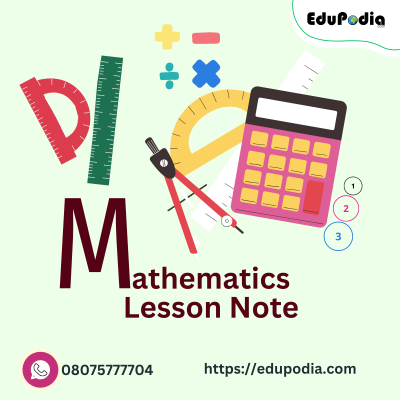Description
These lesson notes cover the following topic for SS1 First, Second and Third Term Mathematics
First Term
- Revision of JSS 3 works. Basic operations of Integers, Addition, Subtraction, Multiplication and Division
- (a) Conversion from One Base To Base Ten (10) or Vice Versa
(b) Conversion Of Decimal Fraction(bicimal) in One Base to Base 10
(c) Conversion of Number from One Base to Another Base
- (a) Addition, Subtraction, Multiplication and Division of Number Bases
(b) Application to Computer Programming
- (a) Concept of Module Arithmetic
(b) Addition, Subtraction and Multiplication Operations in Module Arithmetic.
(c) Application to Daily Life.
- (a) Standard Form
(b) Approximation such as: Rounding off of Numbers: Decimal Places; significant Figures
- Indices (a) Application of the Base Laws: (b) Negative, Zero and Fractional Indices
- Review of the First Half Term’s Work and Periodic Test
- Logarithms:
- Logarithms of Whole Number e.g. 10,100,1000 etc. (in base 10)
- Logarithm Table for Multiplication and Division
- Logarithms (cont’d)
- Calculations Involving Powers and Roots
- Relationship Between Indices and Logarithms
- Simple Equation and Variations
- Change of Subject of Formulae
- Types of Variation such as: Direct, Inverse, Joint and Partial
- Applications of Variations
- Revision of the First Term’s Work and Preparation for Examination
- Examination
Second Term
- Quadratic Equation by (a) Factorization (b) Completing the square method
- General Form of Quadratic Equation leading to Formular Method
- Solutions of Quadratic Equation by Graphical Methods:
- Reading the Roots from the Graph
- Determination of the Minimum and Maximum Values
- Line of
- Idea of Sets:
- Universal Sets, Finite and Infinite Sets, Empty Set, Subset
- Idea of Notation for Union and Intersection of Sets
- Complements of Sets:
- Disjoints of
- Venn Diagramand its Use in Solving Problems Involving two and three Sets Relation to Real Life Situations.
- Review of the First Half Term’s Work and Periodic Test
- Trigonometric Ratios
- Sine, Cosine, Targentof Acute Angles
- Use of Tables of Trigonometric Ratios
- Determination of Length of Chord
- Using Trigonometric Ratios
- Graph of Sine and Cosine for Angles 0o = x
- (a) Application of Sine, Cosine and Tangent, Simple Problems with Respect to Right Angle
- Angles of Elevation and Depression
- Bearing and Distances of Places Strictly Application of Trigonometric
- (a) Introduction of Circle and its Properties
- Calculation of Length of Arc and Perimeter of a Sector
- Area of Sectors and Segments. Area of triangles
- Logic
- Simple True and False Statements
- Negative and Contra Positive of Simple
- Antecedents, Consequence and Conditional Statement (implication)
Third Term
- Mensuration: The Concept of B – D a Shape Cube, Cuboids, Cylinder, Triangular Prism, Cone, Rectangular Based Pyramid, Total Surface Area of Cone, Cylinder and their Volumes.
- (a) Volumes of Frustums of Cone, Rectangular Based Pyramid and other Pyramids
(b) Proofs of Angles Sum of a Triangle = 180o
(c) The Exterior Angle
- Geometrical Construction
- Revision of Construction of Triangle
- Drawing and Bisection of Line Segment
- Construction and Bisection of Angles 90o, 45o, 135o, 221/2o, 571/2o
- Construction and Bisection of Angles: 30o, 60o, 90o, 120o, 150o, etc.
- Construction:
- Construction of Quadrilateral Polygon i.e. four sided figure with given certain conditions parallelogram
- Construction of Equilateral Triangle
- Locus of Moving Points Including Equidistance from Two Lines of Two Points and Constant Distance from the Point.
- Deductive Proof:
- Sum of Angles of a Triangle.
- Relationship of Triangles on a Straight Line.
- Revision of Angles on Parallel Line Cuts by a Transversal Line.
- Congruent Triangles.
- Properties of Parallelogram and Intercept Theorem.
- Statistics
- Collection and Tabulation and Presentation of data e.g. data from height, ages, weight, test and examination scores of students, population of students from different schools, classes etc.
- Different Species of Animals and Types of Vehicles etc.
Calculation of Range, median and mode of ungrouped data
- Data Already Collected by the Students
- Data Collected from Other Statistical Records
- Revision
- Collection, Tabulation and Presentation of Grouped Data
- Data from height, ages, weights, test and examination scores of students
- Population of students from different classes.
- Calculation of Range, Median and Mode of Grouped Data
- Data already collected by the students
- Other statistical records
- Statistical Graphs:
- Drawing of bar chart, pie-chart and histogram
- Cumulative frequency curve
- Reading and drawing inferences from the graph
- (a) Mean deviation, Variance and standard deviation of grouped data use in solving practical problems related to real life situations
- Revision/Examination
To get your copies of the Complete First to Third Term SS1 Mathematics Lesson Note, scroll up and click on the “order now” button!




Reviews
There are no reviews yet.